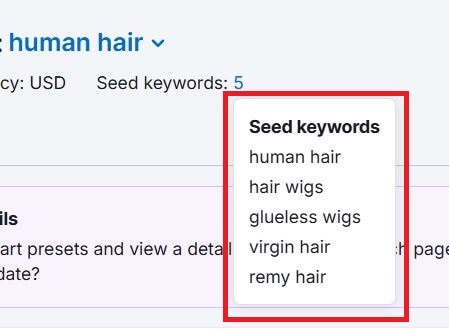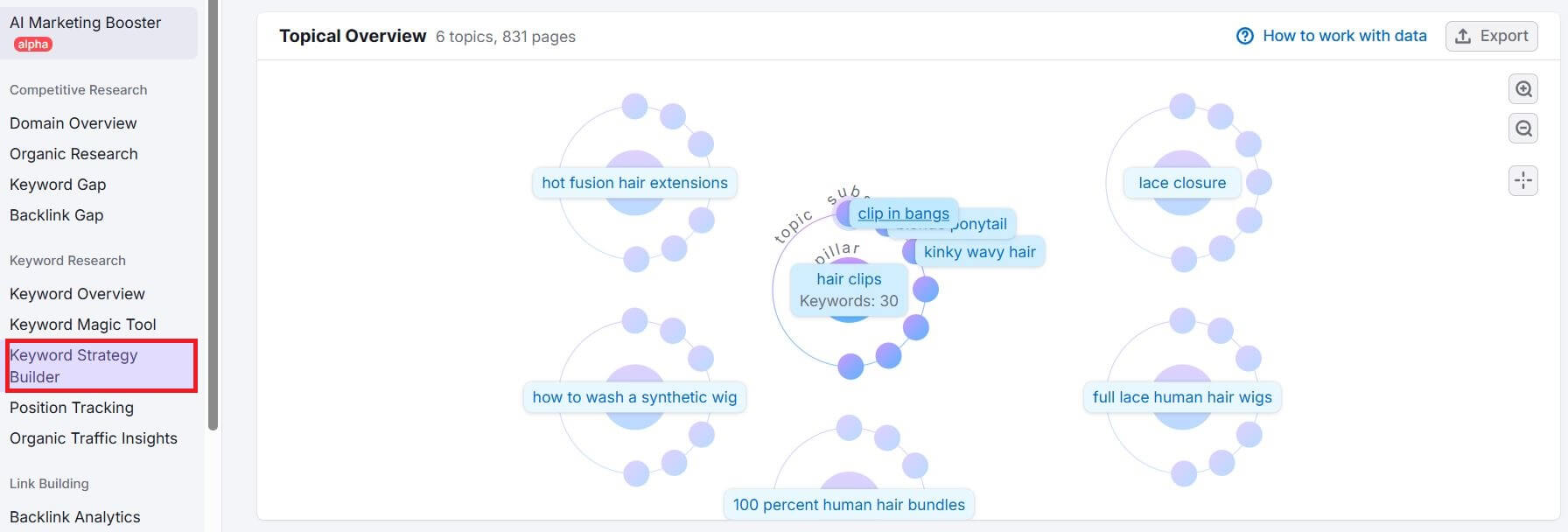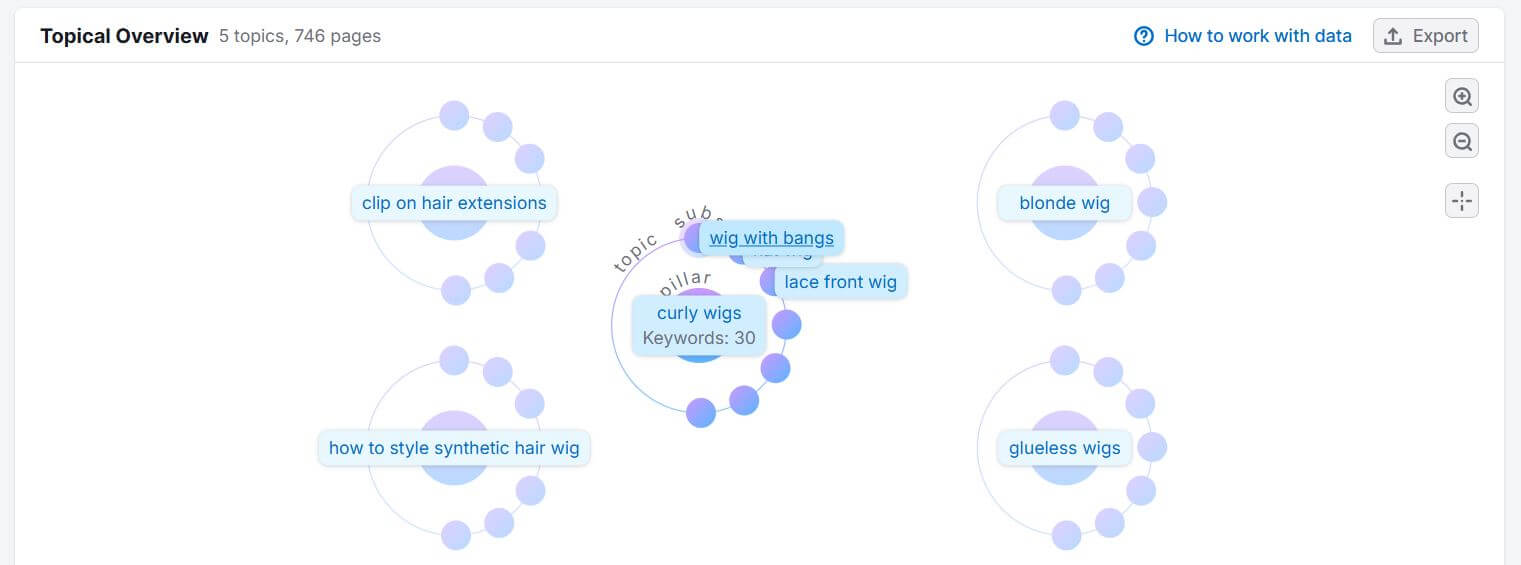Intro: Data Over Opinions
I’m not going to waste your time with fluff. I’ll show you a case study of exactly how I used keyword research to drive 106k+ impressions for an e-commerce website that sells hair extensions and human hair wigs. This isn’t theory. This is a real example of e-commerce keyword research done right—with structure, intent, and clean execution.

Step 1: Set the Foundation with Seed Keywords
Start with Core Terms
Before diving into any tool, I built a list of seed keywords. Simple terms like:
-
human hair wigs
-
glueless wigs
-
lace front wigs
-
blonde wig
-
virgin hair
-
remy hair
These were the base terms I knew my audience was searching for. The goal: find real search demand. No guesswork.

Step 2: Use SEMrush Keyword Strategy Builder
Expand and Filter
I used SEMrush’s Keyword Strategy Builder to expand each seed keyword into clusters. This tool helped me:
-
Identify long-tail variations
-
Spot high-volume keywords with commercial intent
-
Avoid low-value or misleading queries
I filtered out competitor brand names. No point ranking for keywords that won’t convert or violate trademark guidelines.

Step 3: Categorize by Page Type
Structure the Site for Intent
Once I had a solid list, I separated the keywords into three core categories:
-
Pillar pages
-
Subpages
-
Blog/tags pages
Example:
-
Pillar Page: human hair wigs
-
Subpages: glueless wigs, lace front wigs, short blonde wigs
-
Blog/Tags: how to style lace wigs, best wigs for summer, wig care tips
Each subpage supported the pillar with internal links. The content answered user intent clearly and directly.

Step 4: Build Internal Linking Like a Web
Map the Content for Search Engines
I didn’t just toss links around. I created a map.
-
Every subpage is linked to the pillar
-
Relevant blog posts linked across subpages
-
Tags pages acted as navigational hubs
This web made Google crawl deeper. It improved indexing, time-on-site, and user flow.

Step 5: Use ChatGPT (Free) + Manual Editing
Combine AI Speed with Human Oversight
I used free ChatGPT to write rough blog drafts. Then I edited every single article myself. Why? Because Google EEAT (Experience, Expertise, Authoritativeness, Trustworthiness) matters. Machine-written content won’t hit all marks unless a human polishes it.
Step 6: Optimize for Featured Snippets and Voice Search
Structure for Smart Search Results
Most articles followed a question-answer format. This helped my content rank in:
-
Featured snippets
-
People Also Ask
-
AI-generated summaries
-
Voice search results
Example:
Question: Why is keyword research important in e-commerce?
Answer: Because it connects product pages to what real buyers are typing into Google. Without keyword research, you’re guessing.
Step 7: Build for Google’s Keyword Density Guidelines
Stay Natural, Stay Effective
I used all targeted keywords naturally. Zero stuffing. Every keyword appeared where it made sense—title tags, meta descriptions, headers, and body content.
Example from one blog title:
The Beginner’s Guide to Keyword Research for E-commerce
Keywords used:
-
keyword research for e-commerce site
-
ecommerce seo keyword research
-
keyword research strategy for e-commerce
The density stayed within safe ranges. No penalty bait.
Step 8: Track Results Like a Scientist
Use Real Metrics, Not Assumptions
After publishing and interlinking the pages:
-
I tracked impressions using Google Search Console
-
I looked at keyword rankings weekly
-
I noted which pages showed up in Featured Snippets or AI summaries
In under 60 days, the site hit 106k+ impressions.
Common Questions I Ranked For (and Answered)
How to do keyword research for ecommerce?
Start with seed terms. Expand using SEMrush. Cluster by intent. Map content. Link internally. Track results.
Why is keyword research so important for ecommerce content?
Because it directly affects who finds your site and what they buy. Good keywords = better traffic = more conversions.
What is ecommerce keyword research site architecture?
It’s the structure of how keywords are mapped to pages and how those pages link together.
What’s a keyword research strategy for ecommerce that works?
Focus on intent. Avoid brand keywords. Build topic clusters. Use internal linking smartly. Keep content clean.
Lessons Learned
Don’t Skip Intent
Some keywords are just browsing terms. Go for ones that show buyer intent.
Internal Links Work
A clean structure gets real results.
Edit Your AI Content
Free tools are fine—if you edit. Don’t rely 100% on AI content. Google won’t trust it.
EEAT Always Matters
Make sure your name, credentials, and experience show up on your content.
Write Simply
Google understands clear, direct writing. No need to sound like a thesaurus.
Final Results Snapshot
-
106k+ impressions in 60 days
-
Featured Snippet wins
-
Voice search rankings
-
Blog and tags pages in AI search summaries
-
Users are staying longer, clicking more
Wrap-Up
Keyword research for e-commerce sites is not just about volume—it’s about mapping keywords to the right place and building a system around them.
If you’re wondering how to get started, go back to your seed keywords. Build from there. Skip trends. Stick to what your audience is actually searching for.
And yes, track everything. Guesswork is dead.
Frasat Ali is a seasoned SEO Manager with over a decade of experience helping websites improve visibility through ethical, data-backed strategies. He shares actionable SEO insights grounded in real-world success. Read More
![]()
